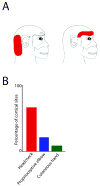The multisensory roles for auditory cortex in primate vocal communication
- PMID: 19371776
- PMCID: PMC2787678
- DOI: 10.1016/j.heares.2009.04.003
The multisensory roles for auditory cortex in primate vocal communication
Abstract
Primate vocal communication is a fundamentally multisensory behavior and this will be reflected in the different roles brain regions play in mediating it. Auditory cortex is illustrative, being influenced, I will argue, by the visual, somatosensory, proprioceptive and motor modalities during vocal communication. It is my intention that the data reviewed here suggest that investigating auditory cortex through the lens of a specific behavior may lead to a much clearer picture of its functions and dynamic organization. One possibility is that, beyond its tonotopic and cytoarchitectural organization, the auditory cortex may be organized according to ethologically-relevant actions. Such action-specific representations would be overlayed on top of traditional mapping schemes and would help mediate motor and multisensory processes related to a particular type of behavior.
Figures





Similar articles
-
Multisensory integration of dynamic faces and voices in rhesus monkey auditory cortex.J Neurosci. 2005 May 18;25(20):5004-12. doi: 10.1523/JNEUROSCI.0799-05.2005. J Neurosci. 2005. PMID: 15901781 Free PMC article.
-
Multisensory interactions in primate auditory cortex: fMRI and electrophysiology.Hear Res. 2009 Dec;258(1-2):80-8. doi: 10.1016/j.heares.2009.02.011. Epub 2009 Mar 6. Hear Res. 2009. PMID: 19269312 Review.
-
Neuronal mechanisms, response dynamics and perceptual functions of multisensory interactions in auditory cortex.Hear Res. 2009 Dec;258(1-2):72-9. doi: 10.1016/j.heares.2009.06.018. Epub 2009 Jul 10. Hear Res. 2009. PMID: 19595755 Free PMC article. Review.
-
Multisensory Competition Is Modulated by Sensory Pathway Interactions with Fronto-Sensorimotor and Default-Mode Network Regions.J Neurosci. 2015 Jun 17;35(24):9064-77. doi: 10.1523/JNEUROSCI.3760-14.2015. J Neurosci. 2015. PMID: 26085631 Free PMC article. Clinical Trial.
-
Hemodynamic responses in human multisensory and auditory association cortex to purely visual stimulation.BMC Neurosci. 2007 Feb 6;8:14. doi: 10.1186/1471-2202-8-14. BMC Neurosci. 2007. PMID: 17284307 Free PMC article.
Cited by
-
Is Reduced Visual Processing the Price of Language?Brain Sci. 2022 Jun 12;12(6):771. doi: 10.3390/brainsci12060771. Brain Sci. 2022. PMID: 35741656 Free PMC article.
-
The natural statistics of audiovisual speech.PLoS Comput Biol. 2009 Jul;5(7):e1000436. doi: 10.1371/journal.pcbi.1000436. Epub 2009 Jul 17. PLoS Comput Biol. 2009. PMID: 19609344 Free PMC article.
-
Dynamic faces speed up the onset of auditory cortical spiking responses during vocal detection.Proc Natl Acad Sci U S A. 2013 Nov 26;110(48):E4668-77. doi: 10.1073/pnas.1312518110. Epub 2013 Nov 11. Proc Natl Acad Sci U S A. 2013. PMID: 24218574 Free PMC article.
-
A temporal hierarchy for conspecific vocalization discrimination in humans.J Neurosci. 2010 Aug 18;30(33):11210-21. doi: 10.1523/JNEUROSCI.2239-10.2010. J Neurosci. 2010. PMID: 20720129 Free PMC article.
-
Visual Influences on Auditory Behavioral, Neural, and Perceptual Processes: A Review.J Assoc Res Otolaryngol. 2021 Jul;22(4):365-386. doi: 10.1007/s10162-021-00789-0. Epub 2021 May 20. J Assoc Res Otolaryngol. 2021. PMID: 34014416 Free PMC article. Review.
References
-
- Abry C, Lallouache M-T, Cathiard M-A. How can coarticulation models account for speech sensitivity in audio-visual desynchronization? In: Stork D, Henneke M, editors. Speechreading by humans and machines: models, systems and applications. Springer-Verlag; Berlin: 1996. pp. 247–255.
-
- Barnes CL, Pandya DN. Efferent Cortical Connections of Multimodal Cortex of the Superior Temporal Sulcus in the Rhesus-Monkey. Journal of Comparative Neurology. 1992;318:222–244. - PubMed
-
- Barraclough NE, Xiao D, Baker CI, Oram MW, Perrett DI. Integration of visual and auditory information by superior temporal sulcus neurons responsive to the sight of actions. J Cogn Neurosci. 2005;17:377–91. - PubMed
-
- Beiser A. Processing of twitter-call fundamental frequencies in insula and auditory cortex of squirrel monkeys. Experimental Brain Research. 1998;122:139–148. - PubMed
Publication types
MeSH terms
Grants and funding
LinkOut - more resources
Full Text Sources

